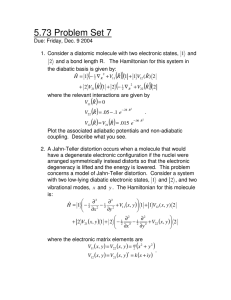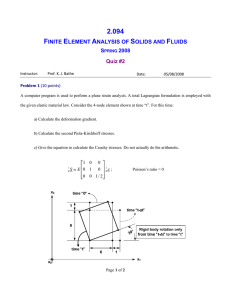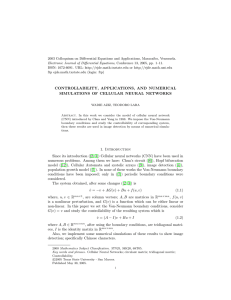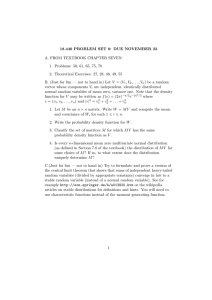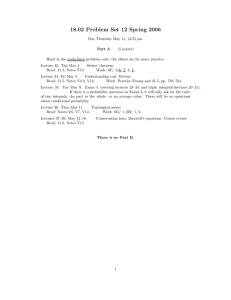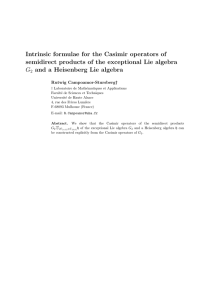Lecture 14 14.1 Estimates of parameters of normal distribu- tion.
advertisement
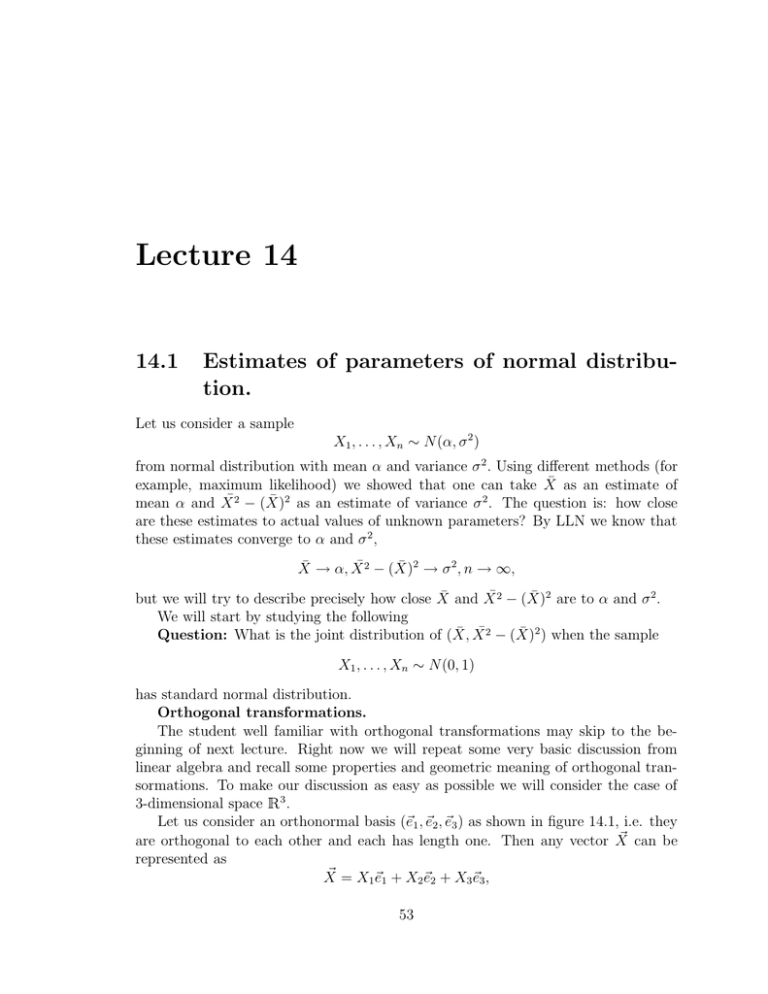
Lecture 14 14.1 Estimates of parameters of normal distribution. Let us consider a sample X1 , . . . , Xn ∼ N (α, σ 2 ) from normal distribution with mean α and variance σ 2 . Using different methods (for example, maximum likelihood) we showed that one can take X̄ as an estimate of mean α and X̄ 2 − (X̄)2 as an estimate of variance σ 2 . The question is: how close are these estimates to actual values of unknown parameters? By LLN we know that these estimates converge to α and σ 2 , X̄ → α, X̄ 2 − (X̄)2 → σ 2 , n → ∞, but we will try to describe precisely how close X̄ and X̄ 2 − (X̄)2 are to α and σ 2 . We will start by studying the following Question: What is the joint distribution of (X̄, X̄ 2 − (X̄)2 ) when the sample X1 , . . . , Xn ∼ N (0, 1) has standard normal distribution. Orthogonal transformations. The student well familiar with orthogonal transformations may skip to the beginning of next lecture. Right now we will repeat some very basic discussion from linear algebra and recall some properties and geometric meaning of orthogonal transormations. To make our discussion as easy as possible we will consider the case of 3-dimensional space 3 . Let us consider an orthonormal basis (~e1 , ~e2 , ~e3 ) as shown in figure 14.1, i.e. they ~ can be are orthogonal to each other and each has length one. Then any vector X represented as ~ = X1~e1 + X2~e2 + X3~e3 , X 53 54 LECTURE 14. X=(X1, X2, X3) e3=(0, 0, 1) e2=(0, 1, 0) Rotate Vectors e1=(1, 0, 0) v3 v2 v1 Transformations Figure 14.1: Unit Vectors Transformation. ~ where (X1 , X2 , X3 ) are the coordinates of vector X Suppose now that we make a rotation (and, maybe, reflection) such that the vectors (~e1 , ~e2 , ~e3 ) go to another orthonormal basis (~v1 , ~v2 , ~v3 ), i.e. |~v1 | = |~v2 | = |~v3 | = 1, ~v1 ⊥ ~v2 ⊥ ~v3 ⊥ ~v1 . Let us denote the coordinates of vector ~vi = (vi1 , vi2 , vi3 ) for i = 1, 2, 3. Then vector ~ is rotated to vector X ~ = X1~e1 + X2~e2 + X3~e3 → X1~v1 + X2~v2 + X3~v3 X = X1 (v11 , v12 , v13 ) + X2 (v21 , v22 , v23 ) + X3 (v31 , v32 , v33 ) v11 v12 v13 ~ = (X1 , X2 , X3 ) v21 v22 v23 = XV, v31 v32 v33 where V is the matrix with elements vij . If we want to make inverse rotation so that vectors (~v1 , ~v2 , ~v3 ) rotate back to ~ by the transpose V T : (~e1 , ~e2 , ~e3 ), we need to multiply vector X v11 v21 v31 ~ → XV ~ T = (X1 , X2 , X3 ) v12 v22 v32 . X v13 v23 v33 Let us check that transpose V T defines inverse rotation. For example, let us check that vector ~v1 = (v11 , v12 , v13 ) goes to ~e1 = (1, 0, 0). We have, 2 2 2 v11 + v12 + v13 , v11 v21 + v12 v22 + v13 v23 , v11 v31 + v12 v32 + v13 v33 ~v1 V T = 55 LECTURE 14. (length of ~v1 )2 , ~v1 · ~v2 , ~v1 · ~v3 = = (1, 0, 0) since (~v1 , ~v2 , ~v3 ) is an orthonormal basis. Therefore, we have proven that ~v1 → ~e1 . Similarly, ~v2 → ~e2 and ~v3 → ~e3 . Note that this inverse rotation V T will send the basis (~e1 , ~e2 , ~e3 ) to ~v10 = (v11 , v21 , v31 ) ~v20 = (v12 , v21 , v32 ) ~v30 = (v13 , v21 , v33 ), - the columns of matrix V, which is, therefore, again an orthonormal basis: |~v10 | = |~v20 | = |~v30 | = 1 ~v10 ⊥ ~v20 ⊥ ~v30 ⊥ ~v10 . This means that both rows and columns of V forms an orthonormal basis. v3’ e3=(0, 0, 1) v2’ v3 e2=(0, 1, 0) e1=(1, 0, 0) v1’ VT Figure 14.2: Unit Vectors Fact. VT v2 v1
